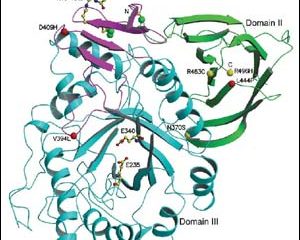
Discovery may help design effective therapies for the genetic disease that mainly affects Ashkenazi Jews
An interdisciplinary team of Weizmann Institute scientists has solved the three-dimensional structure of an enzyme called glucocerebrosidase. Mutations occurring in this enzyme cause Gaucher disease, a genetic illness that mainly affects Ashkenazi Jews. The Institute study, published recently in EMBO Reports, may lead to the design of effective new therapies for treating the disea

Inflation’s got nothing to do with it. Since the beginning of time, a picture has always been worth more than a thousand words. But in this age of information proliferation, that reality is the taproot of a vexing problem that Zhongfei “Mark” Zhang, an assistant professor of computer science at Binghamton University, is determined to help solve.
From personal and commercial digital image libraries and multimedia databases to data mining programs and high-tech security and defense survei
If an asteroid crashes into the Earth, it is likely to splash down somewhere in the oceans that cover 70 percent of the planet’s surface. Huge tsunami waves, spreading out from the impact site like the ripples from a rock tossed into a pond, would inundate heavily populated coastal areas. A computer simulation of an asteroid impact tsunami developed by scientists at the University of California, Santa Cruz, shows waves as high as 400 feet sweeping onto the Atlantic Coast of the United States.
Researchers at Oregon Health & Science University this week announced preliminary study results showing smallpox vaccine protection lasts longer than previously thought. Until now, it was widely accepted that smallpox vaccine protection lasted approximately three to five years. However, early study data shows that significant, partial protection may last many decades after inoculation.
“More than 90 percent of Americans older than 35 have already been vaccinated against smallpox. This trans
Almost every week we hear of a new genome sequence being completed, yet turning sequence information into knowledge about what individual genes do is very difficult. An article published in Journal of Biology this week will simplify this task, as it describes a new online tool that dramatically improves predictions of how individual genes are regulated. Dr. Wyeth Wasserman and his team have created this powerful new two-step method for identifying which regulators of gene expression, called

A study of a common wild mouse by two University of Illinois at Chicago biologists has found evidence of dramatic evolutionary change in a span of just 150 years, suggesting genetic evolution can occur a lot faster than many had thought possible.
The findings are the first report of such quick evolution in a mammal and appear in the May 22 issue of the journal Nature.
Oliver Pergams, a conservation biology researcher with the Chicago Zoological Society in Brookfield, Ill. and visiting